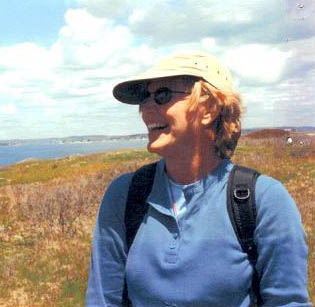Cynthia Loftin
Research Interests
Wetlands
Landscape and Systems Ecology
GIS Applications
Media Expertise:
Wetland Ecology
Systems Ecology
Landscape Ecology
Geographic Information Systems
Wildlife Ecology
Research Projects
Protecting Natural Resources at the Community Scale
Degrees:
- University of Florida, Ph.D. (Wildlife Ecology and Conservation)
- Auburn University, M.S. (Wildlife Management)
- University of Virginia, B.A. (Biology)
Courses
- Applications of Remote Sensing and GIS in Natural Resource Management
- Waterbird Ecology and Management
Profile
Dr. Loftin is a faculty member in the University of Maine’s College of Natural Sciences, Forestry, and Agriculture, as well as the Unit Leader for the U.S. Geological Survey’s Maine Cooperative Fish and Wildlife Unit (MECFWRU). At the University of Maine, Loftin’s interests in systems, landscape, and wetlands ecology drive her research program involving landscape change and wetlands restoration issues. Her primary research interests are conservation and restoration of perturbed freshwater systems and applications of GIS to understand effects of landscape change on ecological systems.
As a scientist in the MECFWRU, Dr. Loftin’s research program reflects the information needs of the Unit Cooperators (Maine Inland Fisheries and Wildlife, U.S. Fish and Wildlife Service, U.S. Geological Survey, Wildlife Management Institute, and University of Maine). Education and training are an integral part of the Cooperative Research Units program, and Dr. Loftin addresses this by supervising graduate students and post-doctoral students who collaborate with her in her research program. In addition to supervising research and providing graduate classroom instruction, Dr. Loftin provides technical assistance to the Unit’s cooperating agencies and the general public as needed.
Dr. Loftin’s current studies with the MECFWRU include examining amphibian use of aquatic systems and the surrounding terrestrial area in wetland-limited landscapes; identifying priority conservation areas for amphibians and reptiles; characterizing wetlands supporting shrubby cinquefoil, a host plant for the state-endangered Clayton’s copper butterfly; examining spatial relationships between native bee pollinators and the patterns and composition of landscapes surrounding selected focal crops in the northeast; documenting avian communities in northern conifer forests and their relationships with forest structure; and examining relationships between seabird productivity and food resource dynamics in the Gulf of Maine system. Dr. Loftin’s research has been funded by the U.S. Fish and Wildlife Service, the U.S. Geological Survey, the Maine Department of Inland Fisheries and Wildlife, the Maine Department of Environmental Protection, The Nature Conservancy, the National Science Foundation, and the Maine Outdoor Heritage Program.
Loftin’s involvement with the SSI vernal pool project (Protecting Natural Resources at the Community Scale) includes working with two of the dozen-plus Maine towns that have participated in the Vernal Pools Mapping and Assessment Project. She works with these communities to develop model solutions that allow regulatory flexibility and help plan development in ways that benefit people and wildlife alike.
In addition to her teaching and research activities, Loftin has been a member of the Black Racer and Freshwater Mussel Advisory Committees of the Maine Department of Inland Fisheries and Wildlife, chaired the University of Maine’s IACUC, served as an Associate Editor for The Journal of Wildlife Management and The Wildlife Society Bulletin, and is currently a member of the Baxter State Park Research Committee.
Selected Publications
S.J. Nelson, K.E. Webster, C.S. Loftin, and K.C. Weathers, “Shifts in Controls on the Temporal Coherence of Throughfall Chemical Flux in Acadia National Park, Maine, USA,” Biogeochemistry 116 (2013): 147-160.
M.Q. Guyette, C.S. Loftin, and J. Zydlewski, “Carcass Analog Addition Enhances Juvenile Atlantic Salmon (Salmo salar) Growth and Condition,” Canadian Journal of Fisheries and Aquatic Sciences 70 (2013): 860-870.
I.M. McCullough, C.S. Loftin, and S.A. Sader, “Landsat Imagery Reveals Declining Clarity of Maine’s Lakes During 1995-2010,” Freshwater Science 32 (2013): 741-752.
I.M. McCullough, C.S. Loftin, and S.A. Sader, “Lakes without Landsat? An Alternative Approach to Remote Lake Monitoring with MODIS 250 m Imagery,” Lake and Reservoir Management 29 (2013): 89-98.
I.M. McCullough, C.S. Loftin, and S.A. Sader, “A Manual for Remote Sensing of Maine Lake Clarity,” Maine Agricultural and Forest Experiment Station Technical Bulletin 207 (2013).
C.S. Loftin, A.J.K. Calhoun, S. Nelson, A. Elskus, and K. Simon, “Mercury Bioaccumulation in Wood Frogs Developing in Seasonal Pools,” Northeastern Naturalist 19 (2012): 579-600.
A.F. Shearin, A.J.K. Calhoun, and C.S Loftin, “Evaluation of Listener-based Amphibian Surveys with Automated Audio Recording Devices,” Wetlands 32 (2012):737-751.
R.C. Freeman, K.P. Bell, A.J.K. Calhoun, and C.S. Loftin, “Incorporating Economic Models into Vernal Pool Conservation Planning: Using Local Land Regulations to Enhance State Regulations,” Wetlands 32 (2012): 509-520.
I.M. McCullough, C.S. Loftin, and S.A. Sader, “High-Frequency Remote Monitoring of Large Lakes with MODIS 500 m Imagery,” Remote Sensing of Environment 124 (2012): 234-241.
T.J. Danielson, C.S. Loftin, L. Tsomides, J.L. DiFranco, B. Connors, D.L. Courtemanch, F. Drummond, and S.P. Davies, “An Algal Model for Predicting Attainment of Tiered Biological Criteria of Maine’s Streams and Rivers,” Freshwater Science 31 (2012): 318-340.
I.M. McCullough, C.S. Loftin, and S.A. Sader, “Combining Lake and Watershed Characteristics with Landsat TM Data for Remote Estimation of Regional Lake Clarity,” Remote Sensing of Environment 123 (2012): 109-115.
T.J. Danielson, C.S. Loftin, L. Tsomides, J.L. DiFranco, and B. Connors, “Algal Bioassessment Metrics for Wadeable Streams and Rivers of Maine, USA,” Journal of the North American Benthological Society 30 (20110: 1033-1048.
R.J. Chalmers and C.S. Loftin, “Plethodon Cinereus, Eastern Red-Backed Salamander, Wetland Habitat,” Herpetological Review 41, no. 4 (2010): 468-469.
Z. Petrin, E.G. Schilling, C.S. Loftin, and F. Johansson, “Predators Shape Distribution and Promote Diversification of Morphological Defenses in Leucorrhinia, Odonata,” Evolutionary Ecology 24 (2010): 1003-1016.
E.G. Schilling, C.S. Loftin, and A.D. Huryn, “Effects of Introduced Fish on Native Macroinvertebrates in Two Types of Historically Fishless Lakes,” Biological Conservation 142 (2009): 3030-3038.
E.G. Schilling, C.S. Loftin, and A.D. Huryn, “Macroinvertebrates as Indicators of Fish Absence in Naturally Fishless Lakes,” Freshwater Biology 54 (2009): 181-202.

